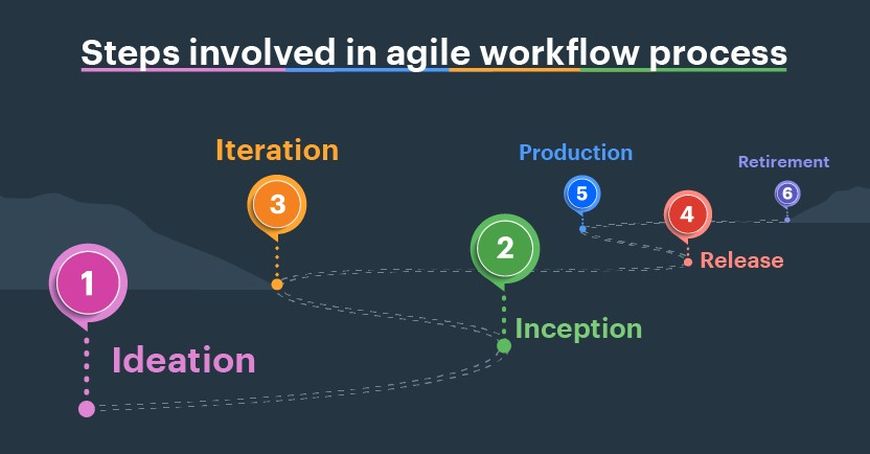In this blog post, we will cover the basics of agile software development. This includes what it is, why you should use it and how to implement it into your company. Agile software development has been around for a while now but is not going anywhere soon. According to Jobtensor Agile Skills such as Scrum and Kanban are among the Most valuable IT Skills and leading firms require people to know agile methodology because of its flexibility and speed. So, let’s get started.
Brief History of ASD
The history of Agile Software Development traces back to the late 1990s when software development methodologies faced increasing challenges in keeping up with rapidly changing business requirements. In 2001, a group of software development thought leaders gathered and formulated the Agile Manifesto, a pivotal moment that set the foundation for Agile methodologies. The manifesto prioritized flexibility, collaboration, agile offshore development, and customer satisfaction over rigid processes and extensive documentation.
Among the early Agile methodologies was Extreme Programming (XP), which introduced practices such as iterative development, continuous feedback, and close collaboration between developers and customers. Another influential methodology, Scrum, formalized the concept of sprints, daily stand-up meetings, and cross-functional teams.
As the Agile movement gained momentum, other methodologies like Kanban, Lean, and DSDM emerged, each contributing their unique principles and practices. Agile methodologies focused on delivering value incrementally, embracing change, and fostering collaboration within teams.
The popularity of Agile surged as organizations recognized its potential to enhance customer satisfaction, accelerate development cycles, and improve adaptability. Agile practices have proven successful across various industries, allowing teams to respond quickly to feedback, continuously improve their processes, and cultivate a culture of collaboration and accountability.
What is Agile Software Development?
Agile software development is a project management methodology that allows technicians to work more efficiently and quickly than other methods like waterfall or scrum. Agile methodologies are based on iterative processes intertwined with each other instead of the linear process used in traditional software development projects.
Benefits of Agile Software Development

With agile, tech companies can be flexible as they go through different iterations (or cycles) within their project life cycle, making it easier for them to make changes along the way if needed. This flexibility gives IT professionals more control over what they want out of an application since going back will not slow down overall production time since you have already completed most tasks. Additionally, agile offshore development can leverage a diverse talent pool, accessing specialized skills and expertise from different regions
It is also much easier to adapt to client needs with agile methodologies because tech companies do not have to rely on a specific plan for their project management strategy to work. This gives clients the freedom they need when it comes time to decide if changes are needed within the app, thus making both IT or tech professionals and their clients happy at the end of development which makes this methodology great for all parties involved.
Every IT company will be different, but depending on how well they implement agile processes into their workflow, expect things like cost-saving (due to shorter production times) and increased overall satisfaction from users/customers who get what they want faster. Of course, there are always two sides to every coin, and IT companies may run into problems like the possibility of indecisiveness if their team cannot make up its mind or becomes too involved with client feedback.
Another thing agile is known for is speed. Projects move fast, which means IT professionals only have a certain amount of time to allocate on any given project before it gets pushed back to another phase in development (or scrapped altogether). This means IT pros must be efficient while working on apps but at the same time should not forget about quality because that will drive away users/customers faster than anything else. It’s all about striking a balance between these two areas when using this methodology. Hence, IT employees who think about transitioning to agile software development need to make sure they are ready for this new challenge.
Agile Development Methodologies

The Agile family of methodologies has been around since the early 2000s, and it’s spreading like wildfire. With so many practitioners using these different techniques, there are bound to be some that you may not have heard about before!
Some examples include:
1. ASD- Adaptive Software Development;
2. Scrum;
3. Crystal;
4. XP – Extreme Programming;
5. DSDM (Dynamic Systems Development Method);
6. FDD- Feature-Driven Development;
7. ASD- Adaptive Software Development.
8. LSD-Lean Software development.
The Agile Iteration Workflow

Agile iterations are short, intense cycles lasting between two and four weeks. They come with a completion date that must be met by all parties involved for it to succeed. The workflow of an Agile Iteration has five stages:
1. Plan requirements;
2. Develop product;
3. Test software;
4. Deliver iterations;
5. Incorporate feedback.
The Agile Software Development Life Cycle
With agile software development, a product undergoes these 6 phases:
1. Conceptualization: The product owner makes decisions such as defining how much of a project they want in this phase.
2. Inception: A hypothesis on how best an idea can be implemented;
3. Iteration: Changes made based on user feedback and testing those assumptions in order to refine what’s been developed so far;
4. Release: Represents when all bugs have been squashed before going out into public or even testers with limited rights but full privileges–this phase ends once there aren’t any more fixes needed for releasing new versions (for example, if something doesn’t work anymore);
5. Maintenance after release: After release, the company is responsible for maintaining and updating their software so it can be used by clients;
6. Retirement: The product may be retired due to replacing it with newer software or because the system has become obsolete.
What about Business Agility?

“What about Business Agility?” You may have heard this question before. It’s a fair point, and one that needs to be addressed.
Business agility is the ability of an organization to react quickly to changes in the market environment or customer needs. For example, if you are a company who sells widgets then it becomes important that you are able to adjust your product offerings as needed when new innovations are made by competitor companies. If you’re not agile enough, then your competitors will take over what was once your niche market! This is just one way business agility can help organizations stay relevant in today’s ever-changing world of technology and innovation. These days, it’s not just about staying competitive in your industry; it’s also about surviving. As a business, you want to focus on your users and delivering value. Agile methodologies can help you do this better.
There are many other benefits beyond increased productivity when considering an agile transformation as well as many benefits to understanding how Agile Software Development works. Agile is not a one-size-fits all approach, but it does provide some great insights into how to create more effective software development teams. The software development process is a collaborative, creative endeavor for agile jobs. This helps teams create better products faster with less risk because they’re able to deliver value quicker than traditional methods allow for. It emphasizes customer involvement and input from start to finish, with constant communication essential for success in this environment- so don’t forget!




